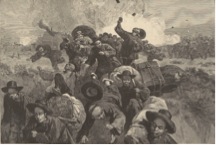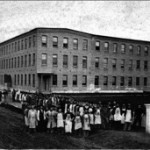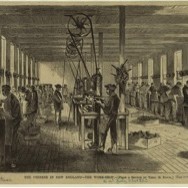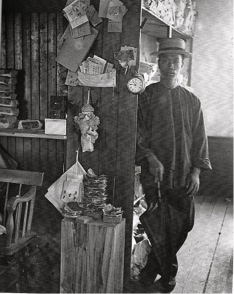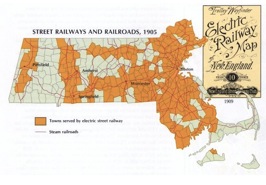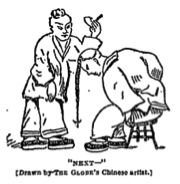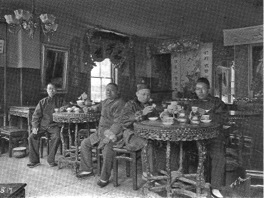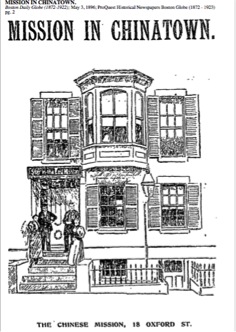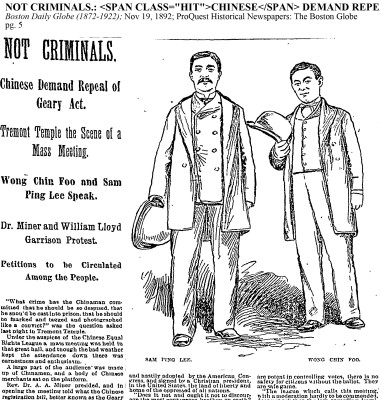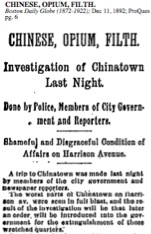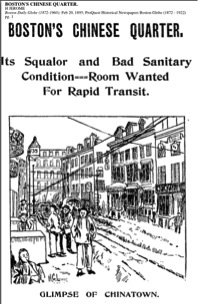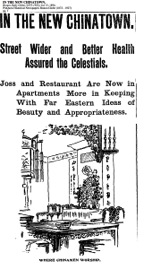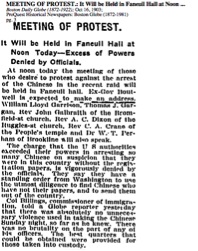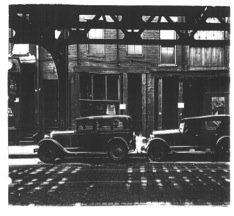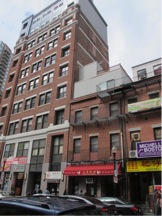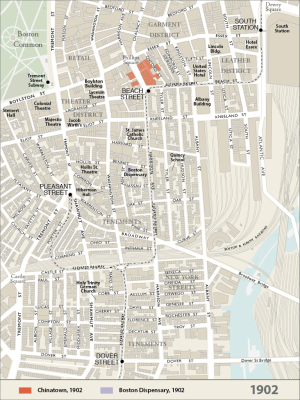 The South Cove was built on landfill in the 1840’s for the railroads and row houses. By the 1870’s, the industrial uses had turned the residences into tenements for new immigrants – the Irish, Germans and Jews.
The South Cove was built on landfill in the 1840’s for the railroads and row houses. By the 1870’s, the industrial uses had turned the residences into tenements for new immigrants – the Irish, Germans and Jews.
Chinese men began to arrive in Boston in the 1870’s. Driven out of the West by anti-Chinese fervor and excluded from factories and stores, they started laundries in Boston and out-lying industrial towns. Because of the Chinese Exclusion Act, the men could not bring their families and lived in isolation in their laundries. By the 1880’s, Chinatown had formed on Harrison Avenue between Essex and Beach Streets to serve their needs. On Sundays, the laundrymen converged on the area to meet with friends, buy food and supplies and sought solace and diversion through gambling and opium. However, Chinatown was viewed as a threat and a blight on the city and many attempts were made to remove it.
In 1900 the “El” was built down Harrison Ave, and Beach St. The noise and dirt drove out all the residents except the Chinese and garment factories.
- Boston economy booms as New England industrializes
- Railroads in all directions connect to Boston
- Downtown Boston expands with retail, theaters, finance, factories and warehouses;
- 1872 Fire and increasing rent drive garment and leather industries south
- Streetcars spur growth into near suburbs
- South Cove deteriorates as immigrants move through
- 1890 – Widening of Harrison Ave. to wipe out Chinatown
- 1900 – South Station consolidates southern and western railways terminals
- 1900 – The El built down Harrison Ave and Beach St. lowering property values
- First phase of new garment buildings
- Irish immigration slows while Jewish and Italian immigration spikes
- Political power passes from Yankees to Irish
- 1882 – Exclusion Act prevents new Chinese immigration
- Ethnic cleansing drives Chinese to industrializing mid-west and north-east
- Chinese excluded from all industries and businesses except laundries
Population – 1900:
- Chinatown – 249
- Boston – 1,186
- Mass – 2,968
EXOTICS AND CURIOSITIES
In 1845, the Chinese Museum on Washington Street recreated a Chinese temple and various rooms outfitted with furniture, paintings, etc. There were cases with exhibits of various artifacts and Chinese musicians in costume. The impetus for the Museum was the opening of China by its defeat in the Opium War. The catalog cites “The zeal and enterprise of individuals have also been awakened. Christian communities are adding to the number of their Missionaries among this nation of idolaters, and merchants are flocking to the shores of China in pursuit of gain.”


EXPULSION FROM THE WEST COAST
On the West Coast and the Mountain States, there were 170,000 Chinese who came during the Gold Rush and the building of the transcontinental railroad. Upon arrival, Chinese workers faced discrimination and hostility. They were paid less for their labor and were often threatened and suffered physical abuse. At the end of the Gold Rush and the completion of the transcontinental railroad, Chinese in the West successfully started fisheries and farms and worked in factories. But their efforts ran up against the increasing influx of European settlers who viewed the Chinese as competitors for jobs. The emerging labor movement using virulent anti-Chinese sentiment drove the Chinese out of manufacturing, agriculture, and other jobs.
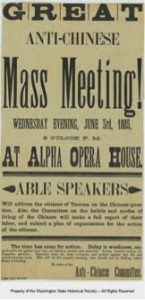
STRIKE BREAKERS IN NORTH ADAMS
In 1870, 75 Chinese from the West coast were recruited by the Sampson Shoe Factory in North Adams, Massachusetts, to break the strike by the workers of the St. Crispins Guild – an organized labor movement of shoemakers. The Chinese workers were not only paid less but were more productive. That further inflamed the labor movement and added to the fear that resulted in Congress passing the 1882 Chinese Exclusion Act, which was extended by Congress in 1892, and subsequently every ten years until it was repealed in 1943.
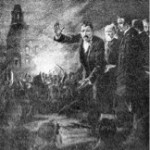
LAUNDRIES
While it is not known if any of the Sampson Shoe Factory workers settled in Boston after their contracts were up, more workers continued to migrate to Boston. Excluded from manufacturing and construction jobs, most of the Chinese opened laundries in the rapidly industrializing towns and cities of Massachusetts and New England with Boston as the “hub” of the rail system.
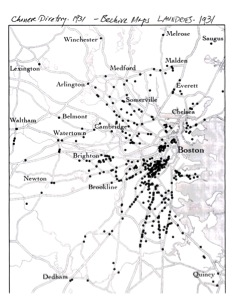
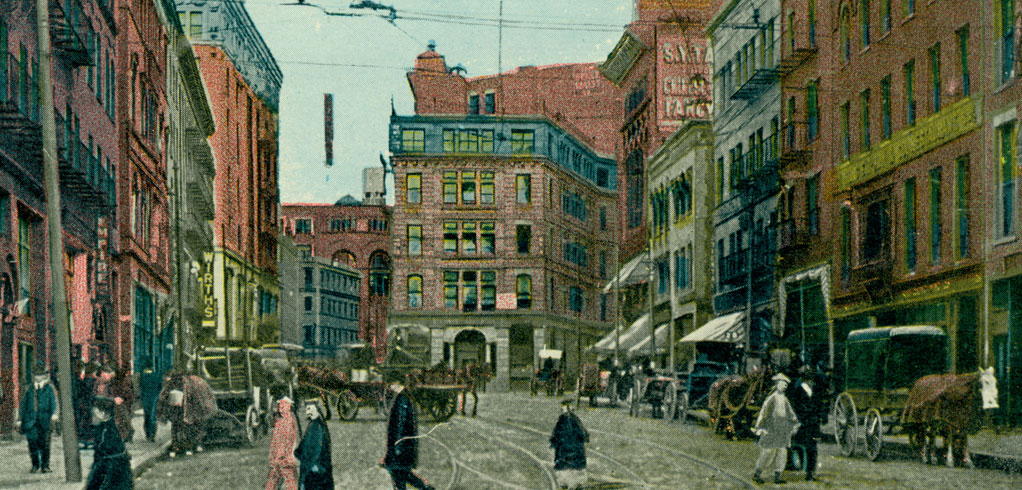
CHINATOWN
By the late 1880s, Chinatown had located on both sides of Harrison Avenue between Essex St. and Beach St. The area had become undesirable because of the many streetcar routes and the manufacturing and warehouse uses generated by the terminus and railroad yards. But that same proliferation of transportation also provided access for the hundreds of Chinese laundrymen scattered throughout the region.
A community base was established with the services and sense of home needed by those who worked hard and lived lonely lives except for Sundays. Because of the Exclusion Act, they were men without their families. There were stores selling groceries and supplies; restaurants serving familiar food; barbers to cut and trim the queues; village associations where letters from home could be picked up and kinsmen to talk to. For entertainment and escape, tongs ran gambling joints and opium dens. Periodic episodes of violence broke out among the tongs over control of illegal activities.
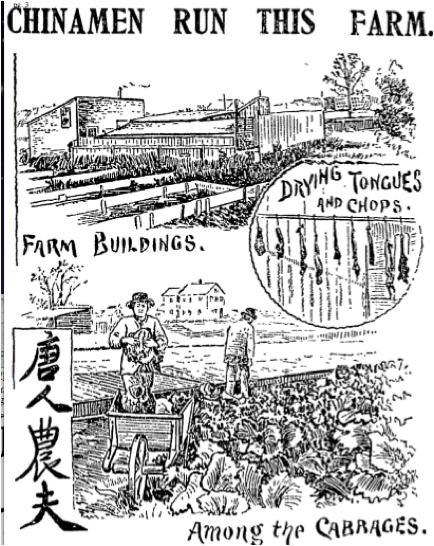
Bostonians were both fascinated and appalled by Chinatown, torn between support and active hostility. Protestant churches in Boston in their evangelical mission established Sunday Schools to provide English lessons and other aid in their effort to convert the Chinese immigrants. That led to the establishment of a permanent mission on Oxford St. and the founding of the Chinese branch of the Young Men’s Christian Association to provide rooms and services for the single men.
The liberal tradition of the abolitionists and churches defended the rights of the Chinese. One of the critics of the Chinese Exclusion Act was the anti-slavery/anti-imperialist Republican Senator George Frisbie Hoar of Massachusetts and William Lloyd Garrison Jr. But the strangeness of the new comers in language, appearance, customs and the indulgence of some of them in opium and gambling caused fear in many, including the fear that the young would be corrupted.
Many attempts were made to drive the Chinese out of Boston – the most damaging of these was the widening of Harrison Avenue, then the center of Chinatown. Ostensibly, this project was to improve traffic flow, but the real intent was to force the Chinese to disperse. However, Chinatown emerged in better shape than before – having rebuilt to higher standards and consolidating their presence on Harrison Avenue, Oxford Place and Oxford Street. But the anti-Chinese furor and demands for expulsion continued to grow. In 1903, the murder of Wong Yak Chong, a Hip Sing Tong member by the On Leong Tong gave the police and the immigration officials the excuse to round up and deport unregistered Chinese. The raid took place on the Sunday of the funeral for Wong when hundreds of laundrymen from the Boston region were rounded up and held if they could not produce the proper papers. Two hundred thirty-four were arrested and about 50 were eventually deported.
Despite the efforts to drive the Chinese out of Boston, Chinatown slowly grew beyond Harrison Avenue. The opportunity for the Chinese to expand was created by the building of the El along Beach Street and degrading property values. The Irish and Germans who had first settled this area left followed later by Syrians and Greeks.
The Garment Industry, which had grown with the demand for ready-made class, established itself near South Station. This enabled the buyers and salesmen to travel to the major market in New York. With land prices depressed by the El, the industry expanded south of Essex Street and multi-story buildings were built, mostly on the corners to take advantage of natural light. The result was a mix of 19th century row-houses occupied by the Chinese and garment factories in loft buildings. The two worlds coexisted but did not mingle. No Chinese worked in the garment industry until after World War II.
